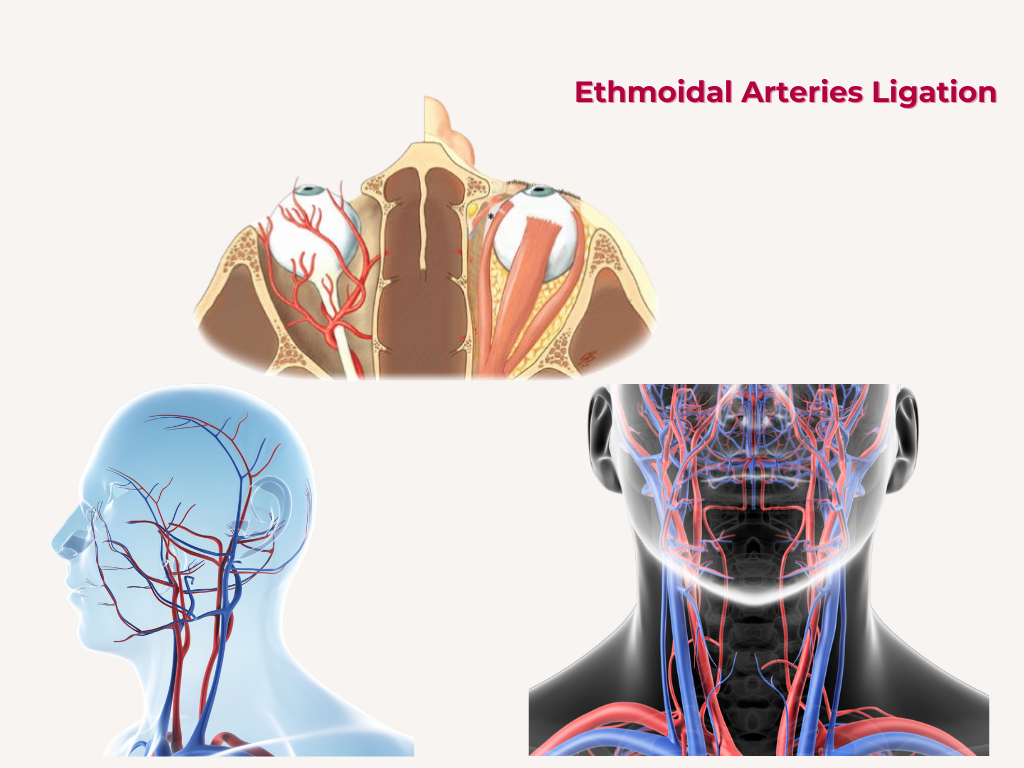
Overview
Ethmoidal arteries ligation is a surgical procedure used to control severe or recurrent epistaxis (nosebleed) by ligating the ethmoidal arteries that supply the nasal cavity.
Anatomy of the Ethmoidal Arteries
The ethmoidal arteries are branches of the ophthalmic artery and include:
-
1. Anterior ethmoidal artery
Supplies the anterior part of the nasal septum and lateral nasal wall.
-
2. Posterior ethmoidal artery
Supplies the posterior part of the nasal septum and lateral nasal wall.
Anatomical Variations
Anatomical variations of the ethmoidal arteries can occur, and it's essential to identify these variations preoperatively to avoid complications.
Indications
-
1. Severe or recurrent epistaxis
When conservative measures fail to control bleeding.
-
2. Failed nasal packing or cauterization
When other treatments are ineffective.
Preoperative Investigations
-
Imaging studies
CT or MRI scans may be used to assess the nasal cavity and sinuses.
Preoperative Preparation
-
1. Antibiotics
May be administered to prevent infection.
-
2. Tranexamic acid
May be used to reduce bleeding.
-
3. Blood transfusion
May be necessary if significant blood loss has occurred.
Operative Process
Anesthesia
The procedure is typically performed under general anesthesia.
Position of Patient
The patient is positioned in a supine position with the head elevated.
Types of Endoscope
-
0-degree endoscope
Provides a direct view of the nasal cavity.
-
30-degree endoscope
Offers a wider field of view and is useful for visualizing the ethmoidal arteries.
Procedure
-
1. Uncinectomy
Removal of the uncinate process to access the ethmoidal artery.
-
2. Bullectomy
Removal of the ethmoidal bulla to access the posterior ethmoidal artery.
-
3. Middle meatal antrostomy
Creation of an opening in the middle meatus to access the ethmoidal arteries.
-
4. Localization of the ethmoidal arteries
Identification of the anterior and posterior ethmoidal arteries.
-
5. Ligation of the arteries
Clipping or cauterization of the ethmoidal arteries.
Management
Postoperative Management
-
1. Nasal packing
May be used to control bleeding and support the nasal mucosa.
-
2. Monitoring
Close monitoring of the patient's vital signs and nasal bleeding.
-
3. Nasal irrigation
Saline irrigation may be used to keep the nasal cavity clean and promote healing.
-
4. Intranasal corticosteroids
May be used to reduce inflammation and promote healing.
-
5. Liquid paraffin
May be applied to the nasal cavity to prevent crusting and promote healing.
Open Approach Compared to Endoscopy
Endoscopy is generally preferred over open approaches due to its minimally invasive nature and reduced risk of complications.
Contraindications to Endoscopic SPAL
-
1. Severe nasal septal deviation
May make it difficult to access the ethmoidal arteries.
-
2. Nasal tumors or masses
May obstruct the view or make it difficult to access the arteries.
-
3. Previous nasal surgery
May make the procedure more challenging due to altered anatomy.
Ethmoidal arteries ligation is an effective procedure for controlling severe or recurrent epistaxis. Proper preoperative preparation, surgical technique, and postoperative management are essential for optimal outcomes.
Want to Know More of
Nosebleeds (epistaxis) can be alarming, but most cases can be managed with simple first aid. Here’s what you need to know. . . . . . . . . . . . . . . . . . . . .
Share Post On:
Recent Posts
-
Nuggets of ORL-RHINOLOGY
-
Nuggets of Otorhinolaryngology-Basic sciences
-
Anatomy of the Muscles of the Soft Palate
-
Ethmoidal Arteries Ligation for Epistaxis
-
Submucous Cleft Palate (SMCP)
-
Approach to Ligation of the External Carotid Artery
-
Approach to Managing a 3-Year-Old Boy with a Foreign Body in the nasal cavity.
-
Approach to Managing a 3-Year-Old Boy with a Foreign Body impacted in the ear canal.
-
Endoscopic Sphenopalatine Artery Ligation (ESPAL) for Epistaxis
-
Surgical Management of Epistaxis
-
Technique of Incision and Drainage of Septal Hematoma/Septal Abscess
-
Upper Aerodigestive Tract Foreign Body Impaction
-
Incision and Drainage of Hematoma Auris
-
Rigid Bronchoscopy for Retrieval of Foreign Bodies in Children
-
Foreign Body Impaction in the Larynx, Trachea, and Bronchi
-
Leadership Position is a Tool, not a Trophy
-
Carcinoma of the Oropharynx
-
Peritonsillar Abscess
-
Ethics of Doctor-Patient Relationship
-
Doctor-Patient Relationship Case Scenarios
-
Asymmetrical Tonsils and Approach to Evaluation and Management
-
Nasal Polyposis
-
Rigid Oesophagoscopy and Complication
-
Anatomy of Oesophagus
-
Stridor, Snoring, Stertor And Wheezing: How They Compare
-
Temporomandibular Joint (TMJ)
-
Otoacoustic Emissions
-
Tympanometry
-
Functional Endoscopic Sinus Surgery (FESS)
-
Tracheostomy
-
Clinical Voice Test (CVT) for Hearing Loss
-
Acute Epiglottitis And Approach To Management
-
Synoptic Overview Of Nasopharyngeal Carcinoma
-
Prioritizing Support For People With Disabilities Over Unhealthy Competitions That Marginalise The Downtrodden
-
Otitic Barotrauma
-
Titbits of Informed Consent Process for a Medical or Surgical Procedure
-
Comprehensive Overview of Mpox (Monkeypox)
-
Overview Of Corrosive Ingestion - Acid & Alkalis, and Management Approach
-
Ethical Conundrum
-
Comprehensive Overview of Laryngeal Papillomatosis and HPV Virus
Categories
RELATED POSTS
Get in Touch
Read doctor-produced health and medical information written for you to make informed decisions about your health concerns.

